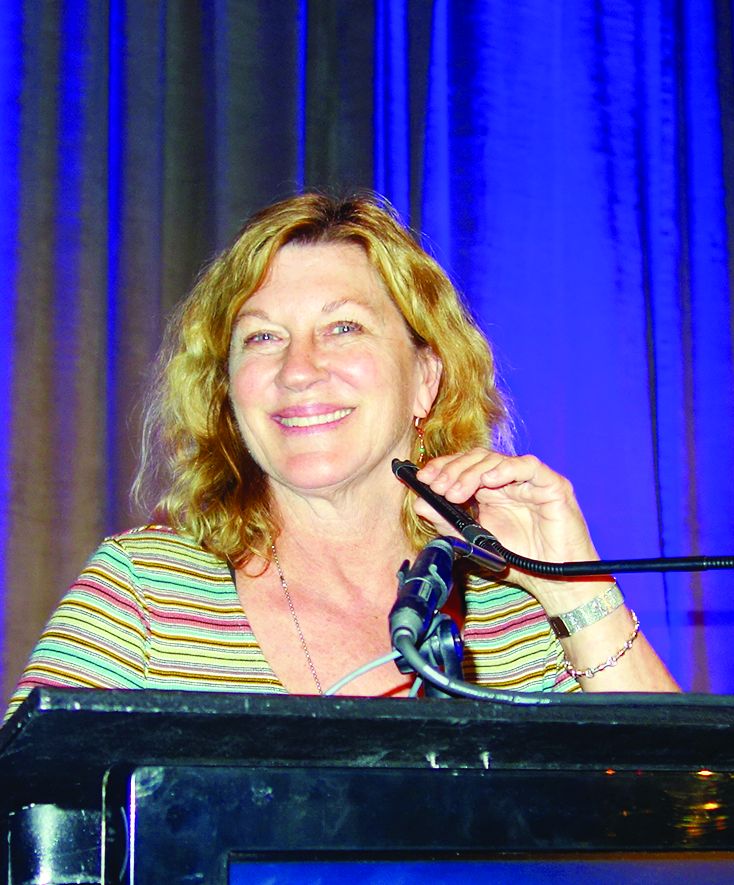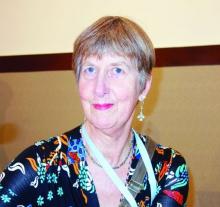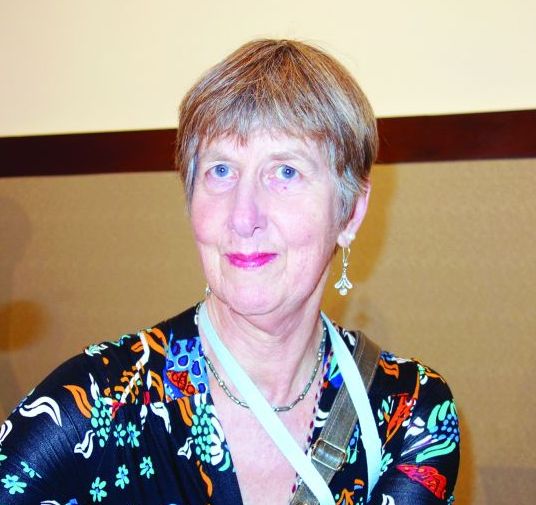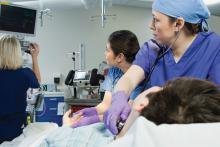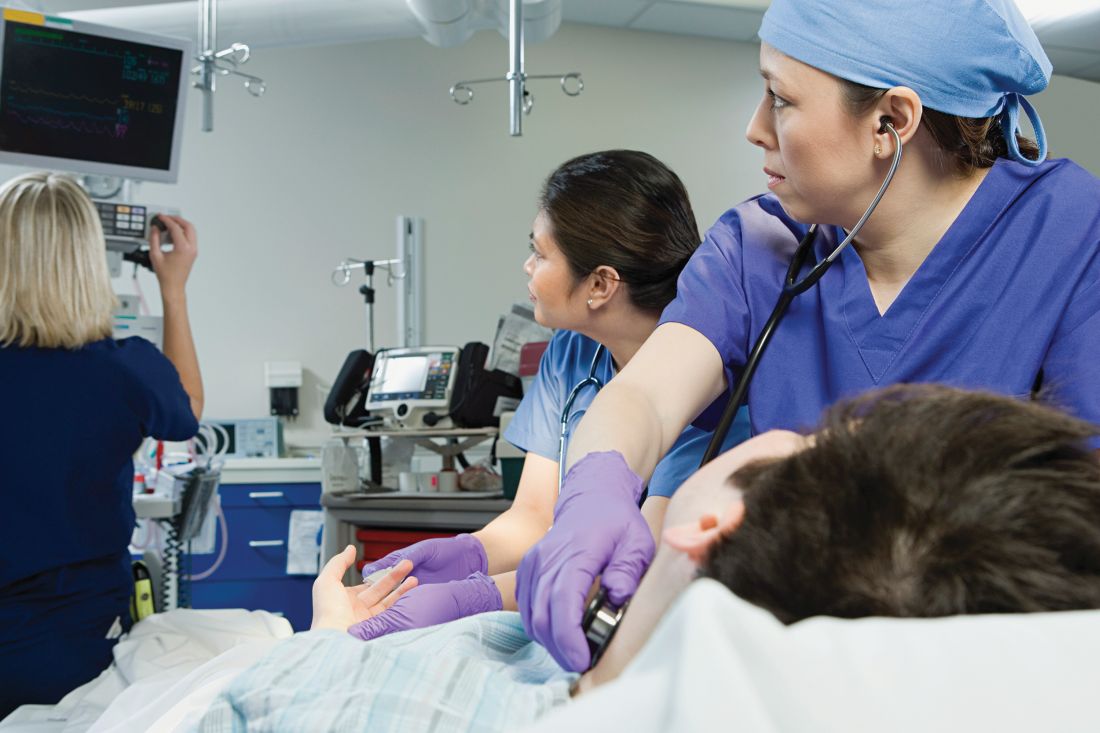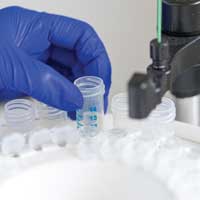User login
M. Alexander Otto began his reporting career early in 1999 covering the pharmaceutical industry for a national pharmacists' magazine and freelancing for the Washington Post and other newspapers. He then joined BNA, now part of Bloomberg News, covering health law and the protection of people and animals in medical research. Alex next worked for the McClatchy Company. Based on his work, Alex won a year-long Knight Science Journalism Fellowship to MIT in 2008-2009. He joined the company shortly thereafter. Alex has a newspaper journalism degree from Syracuse (N.Y.) University and a master's degree in medical science -- a physician assistant degree -- from George Washington University. Alex is based in Seattle.
VIDEO: Stem cells may reverse premature menopause, restore fertility
CHICAGO –
Neither of the women had menstruated for about 5 years; both were in premature menopause and wanted desperately to start a family. Estrogen levels began increasing soon after treatment, and night sweats and other symptoms of menopause almost disappeared. After a year, the treated ovary was almost the size of a normal premenopausal ovary. There weren’t any complications or side effects, and both women are now pursuing pregnancy.
The results are “very exciting, very encouraging,” said senior investigator Ayman Al-Hendy, MD, PhD, a gynecology professor at the University of Illinois at Chicago.
“The eggs are there, but they are not active.” Something about the stem cells seems “to activate these eggs to become fertilizable,” he said.
Far more work is planned on the project, and there’s no shortage of volunteers; premature menopause is a devastating diagnosis to young women hoping to start families.
Dr. Al-Hendy explained the procedure and the next steps in a video interview at the Endocrine Society annual meeting.
The work is supported by MD Stem Cells and the National Institutes of Health. Dr. Al-Hendy didn’t have any relevant disclosures.
SOURCE: Al-Hendy A et al. ENDO 2018, Abstract OR33-6.
CHICAGO –
Neither of the women had menstruated for about 5 years; both were in premature menopause and wanted desperately to start a family. Estrogen levels began increasing soon after treatment, and night sweats and other symptoms of menopause almost disappeared. After a year, the treated ovary was almost the size of a normal premenopausal ovary. There weren’t any complications or side effects, and both women are now pursuing pregnancy.
The results are “very exciting, very encouraging,” said senior investigator Ayman Al-Hendy, MD, PhD, a gynecology professor at the University of Illinois at Chicago.
“The eggs are there, but they are not active.” Something about the stem cells seems “to activate these eggs to become fertilizable,” he said.
Far more work is planned on the project, and there’s no shortage of volunteers; premature menopause is a devastating diagnosis to young women hoping to start families.
Dr. Al-Hendy explained the procedure and the next steps in a video interview at the Endocrine Society annual meeting.
The work is supported by MD Stem Cells and the National Institutes of Health. Dr. Al-Hendy didn’t have any relevant disclosures.
SOURCE: Al-Hendy A et al. ENDO 2018, Abstract OR33-6.
CHICAGO –
Neither of the women had menstruated for about 5 years; both were in premature menopause and wanted desperately to start a family. Estrogen levels began increasing soon after treatment, and night sweats and other symptoms of menopause almost disappeared. After a year, the treated ovary was almost the size of a normal premenopausal ovary. There weren’t any complications or side effects, and both women are now pursuing pregnancy.
The results are “very exciting, very encouraging,” said senior investigator Ayman Al-Hendy, MD, PhD, a gynecology professor at the University of Illinois at Chicago.
“The eggs are there, but they are not active.” Something about the stem cells seems “to activate these eggs to become fertilizable,” he said.
Far more work is planned on the project, and there’s no shortage of volunteers; premature menopause is a devastating diagnosis to young women hoping to start families.
Dr. Al-Hendy explained the procedure and the next steps in a video interview at the Endocrine Society annual meeting.
The work is supported by MD Stem Cells and the National Institutes of Health. Dr. Al-Hendy didn’t have any relevant disclosures.
SOURCE: Al-Hendy A et al. ENDO 2018, Abstract OR33-6.
REPORTING FROM ENDO 2018
Three regular meals a day is best in T2DM
CHICAGO – Spreading calories out over three regular meals a day, instead of six small ones, helps patients with type 2 diabetes lose weight and better control their blood glucose, especially when breakfast is the main meal of the day, according to Israeli investigators.
Too often, obese type 2 patients end up on a treadmill of ever-increasing insulin doses that lead, in turn, to more weight gain and still more insulin, plus greater risk of diabetic complications. “To break this vicious cycle, we need to better control diabetes with less insulin,” said lead investigator Daniela Jakubowicz, MD, an endocrinologist at the Wolfson Medical Center at Tel Aviv University.
The team had a hunch that meal-timing would help, so they randomized 19 obese, uncontrolled type 2 patients to three meals a day, and 18 to six meals. The overall calories were the same in each arm: 1,500-1,800 per day.
Those in the three-meal (3m) group took 50% of their calories at breakfast, mostly from carbohydrates and protein, and consumed by 9:30 a.m. One-third of their calories were consumed at lunch, and the final 17% at dinner, where carbohydrates were not allowed. Between-meal snacking on vegetables was allowed. The six-meal (6m) group took 20%, 25%, and 25% of their calories at breakfast, lunch, and dinner, plus three snacks each consisting of 10% of their daily caloric intake. The study included a few more men than women, and insulin was titrated biweekly in the two groups as needed.
The groups were statistically identical at baseline, with a mean age of about 70 years, a 20-year or so history of type 2 diabetes, and a mean body mass index (BMI) of just under 33 kg/m2. However, at the end of 3 months, the 3m group was doing much better.They had lost a mean of 5.4 kg at that point and reduced their BMI by a mean of 1.9 kg/m2 and their HbA1c 1.2%. The 6m group, meanwhile, gained a mean of 0.26 kg, increased their BMI 0.1 kg/m2, and dropped their HbA1c only 0.2%. Both groups started with a mean HbA1c of around 8%.
Hunger and craving scores improved in the 3m group, as well, and their total daily insulin dose dropped 27 units from a baseline of 74 units; 6m subjects went up 5 units/day, from a baseline of 71 units. The findings were all statistically significant.
In short, the 3m is “more effective than the traditional diet with six small meals evenly distributed along the day, for weight loss, overall glycemia, HbA1c, appetite, and for the reduction of insulin requirements. Therefore, the three-meal schedule with a high-energy breakfast “should be a strategy to improve diabetes control and outcome,” Dr. Jakubowicz said at the annual meeting of the Endocrine Society.
The findings caught the attention of her audience. One endocrinologist said that “patients always ask me about doing six small meals a day.”
Most of the mean blood glucose reduction found in the 3m group happened after only 14 days on the diet, suggesting an improvement in hepatic insulin sensitivity. There was no correlation between glucose levels and weight; the beneficial effects of the 3m diet appeared independent of weight loss.
Those benefits instead might attributable to effects on “clock genes,” which control the circadian oscillation of gene expression. The investigators are looking into the matter further. .
The funding source was not reported. Dr. Jakubowicz, author of “The Big Breakfast Diet” (Workman Publishing Co., 2009), had no other disclosures. The other investigators had no disclosures.
SOURCE: Jakubowicz D et al. ENDO 2018, Abstract OR05-2.
CHICAGO – Spreading calories out over three regular meals a day, instead of six small ones, helps patients with type 2 diabetes lose weight and better control their blood glucose, especially when breakfast is the main meal of the day, according to Israeli investigators.
Too often, obese type 2 patients end up on a treadmill of ever-increasing insulin doses that lead, in turn, to more weight gain and still more insulin, plus greater risk of diabetic complications. “To break this vicious cycle, we need to better control diabetes with less insulin,” said lead investigator Daniela Jakubowicz, MD, an endocrinologist at the Wolfson Medical Center at Tel Aviv University.
The team had a hunch that meal-timing would help, so they randomized 19 obese, uncontrolled type 2 patients to three meals a day, and 18 to six meals. The overall calories were the same in each arm: 1,500-1,800 per day.
Those in the three-meal (3m) group took 50% of their calories at breakfast, mostly from carbohydrates and protein, and consumed by 9:30 a.m. One-third of their calories were consumed at lunch, and the final 17% at dinner, where carbohydrates were not allowed. Between-meal snacking on vegetables was allowed. The six-meal (6m) group took 20%, 25%, and 25% of their calories at breakfast, lunch, and dinner, plus three snacks each consisting of 10% of their daily caloric intake. The study included a few more men than women, and insulin was titrated biweekly in the two groups as needed.
The groups were statistically identical at baseline, with a mean age of about 70 years, a 20-year or so history of type 2 diabetes, and a mean body mass index (BMI) of just under 33 kg/m2. However, at the end of 3 months, the 3m group was doing much better.They had lost a mean of 5.4 kg at that point and reduced their BMI by a mean of 1.9 kg/m2 and their HbA1c 1.2%. The 6m group, meanwhile, gained a mean of 0.26 kg, increased their BMI 0.1 kg/m2, and dropped their HbA1c only 0.2%. Both groups started with a mean HbA1c of around 8%.
Hunger and craving scores improved in the 3m group, as well, and their total daily insulin dose dropped 27 units from a baseline of 74 units; 6m subjects went up 5 units/day, from a baseline of 71 units. The findings were all statistically significant.
In short, the 3m is “more effective than the traditional diet with six small meals evenly distributed along the day, for weight loss, overall glycemia, HbA1c, appetite, and for the reduction of insulin requirements. Therefore, the three-meal schedule with a high-energy breakfast “should be a strategy to improve diabetes control and outcome,” Dr. Jakubowicz said at the annual meeting of the Endocrine Society.
The findings caught the attention of her audience. One endocrinologist said that “patients always ask me about doing six small meals a day.”
Most of the mean blood glucose reduction found in the 3m group happened after only 14 days on the diet, suggesting an improvement in hepatic insulin sensitivity. There was no correlation between glucose levels and weight; the beneficial effects of the 3m diet appeared independent of weight loss.
Those benefits instead might attributable to effects on “clock genes,” which control the circadian oscillation of gene expression. The investigators are looking into the matter further. .
The funding source was not reported. Dr. Jakubowicz, author of “The Big Breakfast Diet” (Workman Publishing Co., 2009), had no other disclosures. The other investigators had no disclosures.
SOURCE: Jakubowicz D et al. ENDO 2018, Abstract OR05-2.
CHICAGO – Spreading calories out over three regular meals a day, instead of six small ones, helps patients with type 2 diabetes lose weight and better control their blood glucose, especially when breakfast is the main meal of the day, according to Israeli investigators.
Too often, obese type 2 patients end up on a treadmill of ever-increasing insulin doses that lead, in turn, to more weight gain and still more insulin, plus greater risk of diabetic complications. “To break this vicious cycle, we need to better control diabetes with less insulin,” said lead investigator Daniela Jakubowicz, MD, an endocrinologist at the Wolfson Medical Center at Tel Aviv University.
The team had a hunch that meal-timing would help, so they randomized 19 obese, uncontrolled type 2 patients to three meals a day, and 18 to six meals. The overall calories were the same in each arm: 1,500-1,800 per day.
Those in the three-meal (3m) group took 50% of their calories at breakfast, mostly from carbohydrates and protein, and consumed by 9:30 a.m. One-third of their calories were consumed at lunch, and the final 17% at dinner, where carbohydrates were not allowed. Between-meal snacking on vegetables was allowed. The six-meal (6m) group took 20%, 25%, and 25% of their calories at breakfast, lunch, and dinner, plus three snacks each consisting of 10% of their daily caloric intake. The study included a few more men than women, and insulin was titrated biweekly in the two groups as needed.
The groups were statistically identical at baseline, with a mean age of about 70 years, a 20-year or so history of type 2 diabetes, and a mean body mass index (BMI) of just under 33 kg/m2. However, at the end of 3 months, the 3m group was doing much better.They had lost a mean of 5.4 kg at that point and reduced their BMI by a mean of 1.9 kg/m2 and their HbA1c 1.2%. The 6m group, meanwhile, gained a mean of 0.26 kg, increased their BMI 0.1 kg/m2, and dropped their HbA1c only 0.2%. Both groups started with a mean HbA1c of around 8%.
Hunger and craving scores improved in the 3m group, as well, and their total daily insulin dose dropped 27 units from a baseline of 74 units; 6m subjects went up 5 units/day, from a baseline of 71 units. The findings were all statistically significant.
In short, the 3m is “more effective than the traditional diet with six small meals evenly distributed along the day, for weight loss, overall glycemia, HbA1c, appetite, and for the reduction of insulin requirements. Therefore, the three-meal schedule with a high-energy breakfast “should be a strategy to improve diabetes control and outcome,” Dr. Jakubowicz said at the annual meeting of the Endocrine Society.
The findings caught the attention of her audience. One endocrinologist said that “patients always ask me about doing six small meals a day.”
Most of the mean blood glucose reduction found in the 3m group happened after only 14 days on the diet, suggesting an improvement in hepatic insulin sensitivity. There was no correlation between glucose levels and weight; the beneficial effects of the 3m diet appeared independent of weight loss.
Those benefits instead might attributable to effects on “clock genes,” which control the circadian oscillation of gene expression. The investigators are looking into the matter further. .
The funding source was not reported. Dr. Jakubowicz, author of “The Big Breakfast Diet” (Workman Publishing Co., 2009), had no other disclosures. The other investigators had no disclosures.
SOURCE: Jakubowicz D et al. ENDO 2018, Abstract OR05-2.
REPORTING FROM ENDO 2018
Key clinical point: Spreading calories out over three regular meals a day, instead of six small ones, helps patients with type 2 diabetes lose weight and better control their blood glucose, especially when breakfast is the main meal of the day.
Major finding: The total daily insulin dose dropped 27 units from a baseline of 74 units among patients assigned to get their calories at three regular meals; among subjects who had them spread out over six meals, the daily insulin dose increased 5 units/day, from a baseline of 71 units.
Study details: Randomized trial with 37 people with type 2 diabetes.
Disclosures: The funding source was not reported. Dr. Jakubowicz, author of “The Big Breakfast Diet” (Workman Publishing Co., 2009), had no other disclosures. The other investigators had no disclosures.
Source: Jakubowicz D et al. ENDO 2018, Abstract OR05-2.
Less vacuum may reduce post–cryolipolysis adipose hyperplasia
KAUAI, HAWAII – Gentler vacuum pressure seems to reduce the risk of paradoxical adipose hyperplasia after cryolipolysis, according to Suzanne Kilmer, MD, director of the Laser and Skin Surgery Center of Northern California, Sacramento.
She and her colleagues have noticed a reduction with the newer CoolAdvantage applicators from Zeltiq Aesthetics, the manufacturer of CoolSculpting equipment. CoolAdvantage runs colder and with less suction than earlier applicators. “It seems to work equally as well,” but with shorter treatment times, less bruising, and less discomfort. Although paradoxical adipose hyperplasia (PAH) “is incredibly rare, it is something we want to reduce, and we do see decreased incidence with these new applicators,” Dr. Kilmer said at the Hawaii Dermatology Seminar provided by Global Academy for Medical Education/Skin Disease Education Foundation.
Typically, one CoolSculpting session will get rid of about 20%-25% of the fat sucked up into the cryolipolysis cup. There can be some discomfort, for instance, when ice crystals are massaged afterward. To ensure patient satisfaction, “you really need to be realistic about what they can expect. It’s likely to be more than one session,” she said.
Another newer option from the manufacturer is the CoolMini applicator for submental fat. Dr. Kilmer generally does two overlapping applications with the CoolMini in the same session, in order to cover as much chin fat as possible. There will be what looks like a stick of butter under the chin when the applicators are removed; it goes away after a few minutes of massage. Patient satisfaction is high, but there can be unveiling of the platysmal bands, which is “something you want to talk to patients about ahead of time,” she said.
She sometimes uses the CoolMini first, followed by the other recently available option for submental fat, deoxycholic acid (Kybella). “We shrink down everything we can with CoolSculpting, and then come back with Kybella to clean up whatever’s left.” Using this approach, patients are injected with less deoxycholic acid, with less inflammation, she said.
“I think you get more fat loss out of a given CoolSculpting treatment than you do with Kybella,” said Dr. Kilmer, who noted that deoxycholic acid is also an option for PAH.
As for going off label with CoolSculpting for jowls, “we’ve done it, and I tell everybody there’s a chance of a 2-3 month palsy. All you are really doing is demyelinating the nerve, not injuring it. If you do liposuction, you actually have a little bit of risk of actually injuring it. You can use a nerve stimulator to map out the nerves beforehand,” she said.
Dr. Kilmer is a consultant for Zeltiq Aesthetics, and an investigator on many of the company’s development trials. She’s also a consultant for Allergan, manufacturer of Kybella, which recently acquired Zeltiq. SDEF/Global Academy for Medical Education and this news organization are owned by the same parent company.
KAUAI, HAWAII – Gentler vacuum pressure seems to reduce the risk of paradoxical adipose hyperplasia after cryolipolysis, according to Suzanne Kilmer, MD, director of the Laser and Skin Surgery Center of Northern California, Sacramento.
She and her colleagues have noticed a reduction with the newer CoolAdvantage applicators from Zeltiq Aesthetics, the manufacturer of CoolSculpting equipment. CoolAdvantage runs colder and with less suction than earlier applicators. “It seems to work equally as well,” but with shorter treatment times, less bruising, and less discomfort. Although paradoxical adipose hyperplasia (PAH) “is incredibly rare, it is something we want to reduce, and we do see decreased incidence with these new applicators,” Dr. Kilmer said at the Hawaii Dermatology Seminar provided by Global Academy for Medical Education/Skin Disease Education Foundation.
Typically, one CoolSculpting session will get rid of about 20%-25% of the fat sucked up into the cryolipolysis cup. There can be some discomfort, for instance, when ice crystals are massaged afterward. To ensure patient satisfaction, “you really need to be realistic about what they can expect. It’s likely to be more than one session,” she said.
Another newer option from the manufacturer is the CoolMini applicator for submental fat. Dr. Kilmer generally does two overlapping applications with the CoolMini in the same session, in order to cover as much chin fat as possible. There will be what looks like a stick of butter under the chin when the applicators are removed; it goes away after a few minutes of massage. Patient satisfaction is high, but there can be unveiling of the platysmal bands, which is “something you want to talk to patients about ahead of time,” she said.
She sometimes uses the CoolMini first, followed by the other recently available option for submental fat, deoxycholic acid (Kybella). “We shrink down everything we can with CoolSculpting, and then come back with Kybella to clean up whatever’s left.” Using this approach, patients are injected with less deoxycholic acid, with less inflammation, she said.
“I think you get more fat loss out of a given CoolSculpting treatment than you do with Kybella,” said Dr. Kilmer, who noted that deoxycholic acid is also an option for PAH.
As for going off label with CoolSculpting for jowls, “we’ve done it, and I tell everybody there’s a chance of a 2-3 month palsy. All you are really doing is demyelinating the nerve, not injuring it. If you do liposuction, you actually have a little bit of risk of actually injuring it. You can use a nerve stimulator to map out the nerves beforehand,” she said.
Dr. Kilmer is a consultant for Zeltiq Aesthetics, and an investigator on many of the company’s development trials. She’s also a consultant for Allergan, manufacturer of Kybella, which recently acquired Zeltiq. SDEF/Global Academy for Medical Education and this news organization are owned by the same parent company.
KAUAI, HAWAII – Gentler vacuum pressure seems to reduce the risk of paradoxical adipose hyperplasia after cryolipolysis, according to Suzanne Kilmer, MD, director of the Laser and Skin Surgery Center of Northern California, Sacramento.
She and her colleagues have noticed a reduction with the newer CoolAdvantage applicators from Zeltiq Aesthetics, the manufacturer of CoolSculpting equipment. CoolAdvantage runs colder and with less suction than earlier applicators. “It seems to work equally as well,” but with shorter treatment times, less bruising, and less discomfort. Although paradoxical adipose hyperplasia (PAH) “is incredibly rare, it is something we want to reduce, and we do see decreased incidence with these new applicators,” Dr. Kilmer said at the Hawaii Dermatology Seminar provided by Global Academy for Medical Education/Skin Disease Education Foundation.
Typically, one CoolSculpting session will get rid of about 20%-25% of the fat sucked up into the cryolipolysis cup. There can be some discomfort, for instance, when ice crystals are massaged afterward. To ensure patient satisfaction, “you really need to be realistic about what they can expect. It’s likely to be more than one session,” she said.
Another newer option from the manufacturer is the CoolMini applicator for submental fat. Dr. Kilmer generally does two overlapping applications with the CoolMini in the same session, in order to cover as much chin fat as possible. There will be what looks like a stick of butter under the chin when the applicators are removed; it goes away after a few minutes of massage. Patient satisfaction is high, but there can be unveiling of the platysmal bands, which is “something you want to talk to patients about ahead of time,” she said.
She sometimes uses the CoolMini first, followed by the other recently available option for submental fat, deoxycholic acid (Kybella). “We shrink down everything we can with CoolSculpting, and then come back with Kybella to clean up whatever’s left.” Using this approach, patients are injected with less deoxycholic acid, with less inflammation, she said.
“I think you get more fat loss out of a given CoolSculpting treatment than you do with Kybella,” said Dr. Kilmer, who noted that deoxycholic acid is also an option for PAH.
As for going off label with CoolSculpting for jowls, “we’ve done it, and I tell everybody there’s a chance of a 2-3 month palsy. All you are really doing is demyelinating the nerve, not injuring it. If you do liposuction, you actually have a little bit of risk of actually injuring it. You can use a nerve stimulator to map out the nerves beforehand,” she said.
Dr. Kilmer is a consultant for Zeltiq Aesthetics, and an investigator on many of the company’s development trials. She’s also a consultant for Allergan, manufacturer of Kybella, which recently acquired Zeltiq. SDEF/Global Academy for Medical Education and this news organization are owned by the same parent company.
EXPERT ANALYSIS FROM SDEF HAWAII DERMATOLOGY SEMINAR
Looking to increase PrEP uptake
BOSTON – More than 1.1 million Americans are at substantial risk for HIV and would benefit from preexposure prophylaxis (PrEP), but only 90,000 prescriptions were filled by retail or mail-order pharmacies in the United States from Sept. 2015 to August 2016, according to the Centers for Disease Control and Prevention.
The CDC estimated that 500,340 blacks in the United States have indications for preexposure prophylaxis, but only about 7,000 (less than 1%) filled a prescription during that time. Among an estimated 282,260 Hispanics who might benefit, just about 7,600 (3%) filled prescriptions. Uptake was a bit higher among whites: about 42,000 prescriptions among 303,230 at-risk people (14%).
PrEP uptake might be particularly low among black and Hispanic people because, in addition to the well-known disparities in health care access and other issues: “There’s a stigma with being gay: ‘If I’m taking this drug, does that mean I’m gay?’ ” Dr. Smith said.
To address the problem, “get more serious about HIV testing. You want to find people who are positive, who need to be on treatment. The second step is to find ways to collect risk-behavior data.” That could be as simple as having the nurse ask a few extra questions before the office visit, or adding a few questions to the intake form, she said at the Conference On Retroviruses And Opportunistic Infections.
“You are trying to help patients acknowledge that they are engaging in behaviors that might have exposed them to HIV, and providers need to be able to hear the answers. One of the problems we have is providers who say ‘my patients aren’t like that,’ or ‘this person is married; I don’t need to ask them.’” Another easy way to find at-risk patients is to look at STD history. If a patient has had syphilis, or two episodes of gonorrhea in the past year, you “need to talk to them about PrEP,” she said.
For black and Hispanic patients, “it’s a higher index of suspicion. For example, you take blood pressure in all your patients, but you are also aware that hypertension is more common in African Americans. So if you’re rushed, you are still going to do a blood pressure in African American patients, but maybe not in the young white jogger; you get that next time.” Especially in high-prevalence HIV settings, “every patient should be aware of PrEP. It should be part of the conversation with everybody,” she said.
The CDC used national pharmacy data and estimates of risky behavior to draw its conclusions. Commercial pharmacies account for maybe 90% of all PrEP prescriptions, so the data slightly underestimate the true use numbers. The more than 1.1 million people included an estimated 813,970 gay and bisexual men, 258,080 heterosexuals, and 72,510 intravenous drug users. The ultimate goal of the work is target PrEP interventions where they are needed most. The agency plans to release state-by-state data soon.
CDC funded the work. Dr. Smith didn’t have any disclosures.
SOURCE: Smith DK et al. 2018 CROI, Abstract 86.
BOSTON – More than 1.1 million Americans are at substantial risk for HIV and would benefit from preexposure prophylaxis (PrEP), but only 90,000 prescriptions were filled by retail or mail-order pharmacies in the United States from Sept. 2015 to August 2016, according to the Centers for Disease Control and Prevention.
The CDC estimated that 500,340 blacks in the United States have indications for preexposure prophylaxis, but only about 7,000 (less than 1%) filled a prescription during that time. Among an estimated 282,260 Hispanics who might benefit, just about 7,600 (3%) filled prescriptions. Uptake was a bit higher among whites: about 42,000 prescriptions among 303,230 at-risk people (14%).
PrEP uptake might be particularly low among black and Hispanic people because, in addition to the well-known disparities in health care access and other issues: “There’s a stigma with being gay: ‘If I’m taking this drug, does that mean I’m gay?’ ” Dr. Smith said.
To address the problem, “get more serious about HIV testing. You want to find people who are positive, who need to be on treatment. The second step is to find ways to collect risk-behavior data.” That could be as simple as having the nurse ask a few extra questions before the office visit, or adding a few questions to the intake form, she said at the Conference On Retroviruses And Opportunistic Infections.
“You are trying to help patients acknowledge that they are engaging in behaviors that might have exposed them to HIV, and providers need to be able to hear the answers. One of the problems we have is providers who say ‘my patients aren’t like that,’ or ‘this person is married; I don’t need to ask them.’” Another easy way to find at-risk patients is to look at STD history. If a patient has had syphilis, or two episodes of gonorrhea in the past year, you “need to talk to them about PrEP,” she said.
For black and Hispanic patients, “it’s a higher index of suspicion. For example, you take blood pressure in all your patients, but you are also aware that hypertension is more common in African Americans. So if you’re rushed, you are still going to do a blood pressure in African American patients, but maybe not in the young white jogger; you get that next time.” Especially in high-prevalence HIV settings, “every patient should be aware of PrEP. It should be part of the conversation with everybody,” she said.
The CDC used national pharmacy data and estimates of risky behavior to draw its conclusions. Commercial pharmacies account for maybe 90% of all PrEP prescriptions, so the data slightly underestimate the true use numbers. The more than 1.1 million people included an estimated 813,970 gay and bisexual men, 258,080 heterosexuals, and 72,510 intravenous drug users. The ultimate goal of the work is target PrEP interventions where they are needed most. The agency plans to release state-by-state data soon.
CDC funded the work. Dr. Smith didn’t have any disclosures.
SOURCE: Smith DK et al. 2018 CROI, Abstract 86.
BOSTON – More than 1.1 million Americans are at substantial risk for HIV and would benefit from preexposure prophylaxis (PrEP), but only 90,000 prescriptions were filled by retail or mail-order pharmacies in the United States from Sept. 2015 to August 2016, according to the Centers for Disease Control and Prevention.
The CDC estimated that 500,340 blacks in the United States have indications for preexposure prophylaxis, but only about 7,000 (less than 1%) filled a prescription during that time. Among an estimated 282,260 Hispanics who might benefit, just about 7,600 (3%) filled prescriptions. Uptake was a bit higher among whites: about 42,000 prescriptions among 303,230 at-risk people (14%).
PrEP uptake might be particularly low among black and Hispanic people because, in addition to the well-known disparities in health care access and other issues: “There’s a stigma with being gay: ‘If I’m taking this drug, does that mean I’m gay?’ ” Dr. Smith said.
To address the problem, “get more serious about HIV testing. You want to find people who are positive, who need to be on treatment. The second step is to find ways to collect risk-behavior data.” That could be as simple as having the nurse ask a few extra questions before the office visit, or adding a few questions to the intake form, she said at the Conference On Retroviruses And Opportunistic Infections.
“You are trying to help patients acknowledge that they are engaging in behaviors that might have exposed them to HIV, and providers need to be able to hear the answers. One of the problems we have is providers who say ‘my patients aren’t like that,’ or ‘this person is married; I don’t need to ask them.’” Another easy way to find at-risk patients is to look at STD history. If a patient has had syphilis, or two episodes of gonorrhea in the past year, you “need to talk to them about PrEP,” she said.
For black and Hispanic patients, “it’s a higher index of suspicion. For example, you take blood pressure in all your patients, but you are also aware that hypertension is more common in African Americans. So if you’re rushed, you are still going to do a blood pressure in African American patients, but maybe not in the young white jogger; you get that next time.” Especially in high-prevalence HIV settings, “every patient should be aware of PrEP. It should be part of the conversation with everybody,” she said.
The CDC used national pharmacy data and estimates of risky behavior to draw its conclusions. Commercial pharmacies account for maybe 90% of all PrEP prescriptions, so the data slightly underestimate the true use numbers. The more than 1.1 million people included an estimated 813,970 gay and bisexual men, 258,080 heterosexuals, and 72,510 intravenous drug users. The ultimate goal of the work is target PrEP interventions where they are needed most. The agency plans to release state-by-state data soon.
CDC funded the work. Dr. Smith didn’t have any disclosures.
SOURCE: Smith DK et al. 2018 CROI, Abstract 86.
REPORTING FROM CROI
Key clinical point: To know if patients need PrEP, you first have to ask about at-risk behaviors.
Major finding: About 500,340 blacks have indications for preexposure prophylaxis (PrEP), but only about 7,000 filled a prescription from Sept. 2015-August 2016.
Study details: The findings are based on pharmacy data and estimates of risky behavior.
Disclosures: CDC funded the work. The lead investigator didn’t have any disclosures.
Source: Smith DK et al. 2018 CROI, Abstract 86.
Raltegravir not associated with IRIS in African trial
BOSTON – A randomized trial in sub-Saharan Africa found no evidence that first-line raltegravir (Isentress)triggers immune reconstitution syndrome in HIV patients.
It’s an important finding because raltegravir and other integrase inhibitors are replacing nonnucleoside reverse-transcriptase inhibitors (NNRTIs) as first-line treatments for HIV. There have been a few reports from observational studies that among severely immunocompromised, the rapid drop in viral load (VL) with the drugs might trigger immune reconstitution syndrome (IRIS), an exaggerated, dysfunctional, and sometimes fatal response to pathogens as the immune system begins to recover.
The 1,805 subjects in those four countries – a few children, but mostly adults – started the trial with median baseline CD4 counts of 37 cells/mcL and VLs of 249,770 copies/mL; 903 were randomized to standard treatment with two nucleoside reverse transcriptase inhibitors plus one NNRTI (Efavirenz), while 902 were randomized to the same regimen but with raltegravir during the first 12 weeks.
As expected, VLs came down very fast in the raltegravir group to a mean of only 80 copies/mL at 4 weeks, vs. a mean of 480 copies/mL in the standard treatment arm.
After a median of about a month, 225 fatal and 113 nonfatal IRIS events (adjudicated by a review committee blinded to randomization) occurred in 9.9% of patients in the raltegravir arm and 9.5% of patients on standard treatment, a nonsignificant difference (P = .79). IRIS was fatal in 4% of raltegravir patients and 3.4% of standard-care patients, also a nonsignificant difference (P = .54).
In both groups, TB-IRIS occurred in about 6%, cryptococcal-IRIS in about 2%, and IRIS of unknown etiology in about 2%. Also in both groups, IRIS risk was highest among older subjects as well as those who went into treatment with particularly low CD4 counts or tuberculosis (TB).
“Basically, the increase in IRIS was not there. We believe these results can be extrapolated across the class of integrase inhibitors. This provides great reassurance,” especially given the prospect of first-line integrase inhibitors in developing countries, where patients tend to present with more advanced disease, said lead investigator Diana Gibb, MD, an epidemiology professor and researcher at the University College London at the Conference on Retroviruses and Opportunistic Infections.
The wrinkle in the findings was that “we didn’t see any benefit to adding raltegravir to the first 12 weeks of treatment. Everyone thought that by [driving] down the viral load faster, you might get less disease progression, and so fewer deaths. We didn’t see any difference at all. The mortality was identical at 24 weeks [around 10.5% in both arms] and at 48 weeks [around 12.5%]. The same if you looked at” severe AIDS complications, she said.
Fast, steep declines in VL “might not necessarily translate” to clinical benefit, Dr. Gibb said.
What did make a difference was IRIS prophylaxis.
The study included a second randomization at baseline, 906 subjects were randomized to enhanced prophylaxis with isoniazid, fluconazole, azithromycin, trimethoprim-sulfamethoxazole, and single-dose albendazole (Albenza); 899 others were randomized to standard prophylaxis with trimethoprim-sulfamethoxazole alone (N Engl J Med. 2017 Jul 20;377[3]:233-45).
Enhanced prophylaxis nearly halved the incidence of IRIS from 12% to 7.4%, and significantly reduced deaths at 48 weeks from 14.4% to 11% (P = .04).
“Patients with very low CD4 counts and high viral loads are the patients where this enhanced protocol package would be useful,” Dr. Gibb said.
The median age in the trial was 36 years; 4% of the subjects were 5-17 years old. Just over half the subjects were male.
The work was supported by the U.K. Department for International Development, the Wellcome Trust, and others. Dr. Gibb didn’t have any disclosures.
SOURCE: Gibb D et al. CROI, Abstract 23.
BOSTON – A randomized trial in sub-Saharan Africa found no evidence that first-line raltegravir (Isentress)triggers immune reconstitution syndrome in HIV patients.
It’s an important finding because raltegravir and other integrase inhibitors are replacing nonnucleoside reverse-transcriptase inhibitors (NNRTIs) as first-line treatments for HIV. There have been a few reports from observational studies that among severely immunocompromised, the rapid drop in viral load (VL) with the drugs might trigger immune reconstitution syndrome (IRIS), an exaggerated, dysfunctional, and sometimes fatal response to pathogens as the immune system begins to recover.
The 1,805 subjects in those four countries – a few children, but mostly adults – started the trial with median baseline CD4 counts of 37 cells/mcL and VLs of 249,770 copies/mL; 903 were randomized to standard treatment with two nucleoside reverse transcriptase inhibitors plus one NNRTI (Efavirenz), while 902 were randomized to the same regimen but with raltegravir during the first 12 weeks.
As expected, VLs came down very fast in the raltegravir group to a mean of only 80 copies/mL at 4 weeks, vs. a mean of 480 copies/mL in the standard treatment arm.
After a median of about a month, 225 fatal and 113 nonfatal IRIS events (adjudicated by a review committee blinded to randomization) occurred in 9.9% of patients in the raltegravir arm and 9.5% of patients on standard treatment, a nonsignificant difference (P = .79). IRIS was fatal in 4% of raltegravir patients and 3.4% of standard-care patients, also a nonsignificant difference (P = .54).
In both groups, TB-IRIS occurred in about 6%, cryptococcal-IRIS in about 2%, and IRIS of unknown etiology in about 2%. Also in both groups, IRIS risk was highest among older subjects as well as those who went into treatment with particularly low CD4 counts or tuberculosis (TB).
“Basically, the increase in IRIS was not there. We believe these results can be extrapolated across the class of integrase inhibitors. This provides great reassurance,” especially given the prospect of first-line integrase inhibitors in developing countries, where patients tend to present with more advanced disease, said lead investigator Diana Gibb, MD, an epidemiology professor and researcher at the University College London at the Conference on Retroviruses and Opportunistic Infections.
The wrinkle in the findings was that “we didn’t see any benefit to adding raltegravir to the first 12 weeks of treatment. Everyone thought that by [driving] down the viral load faster, you might get less disease progression, and so fewer deaths. We didn’t see any difference at all. The mortality was identical at 24 weeks [around 10.5% in both arms] and at 48 weeks [around 12.5%]. The same if you looked at” severe AIDS complications, she said.
Fast, steep declines in VL “might not necessarily translate” to clinical benefit, Dr. Gibb said.
What did make a difference was IRIS prophylaxis.
The study included a second randomization at baseline, 906 subjects were randomized to enhanced prophylaxis with isoniazid, fluconazole, azithromycin, trimethoprim-sulfamethoxazole, and single-dose albendazole (Albenza); 899 others were randomized to standard prophylaxis with trimethoprim-sulfamethoxazole alone (N Engl J Med. 2017 Jul 20;377[3]:233-45).
Enhanced prophylaxis nearly halved the incidence of IRIS from 12% to 7.4%, and significantly reduced deaths at 48 weeks from 14.4% to 11% (P = .04).
“Patients with very low CD4 counts and high viral loads are the patients where this enhanced protocol package would be useful,” Dr. Gibb said.
The median age in the trial was 36 years; 4% of the subjects were 5-17 years old. Just over half the subjects were male.
The work was supported by the U.K. Department for International Development, the Wellcome Trust, and others. Dr. Gibb didn’t have any disclosures.
SOURCE: Gibb D et al. CROI, Abstract 23.
BOSTON – A randomized trial in sub-Saharan Africa found no evidence that first-line raltegravir (Isentress)triggers immune reconstitution syndrome in HIV patients.
It’s an important finding because raltegravir and other integrase inhibitors are replacing nonnucleoside reverse-transcriptase inhibitors (NNRTIs) as first-line treatments for HIV. There have been a few reports from observational studies that among severely immunocompromised, the rapid drop in viral load (VL) with the drugs might trigger immune reconstitution syndrome (IRIS), an exaggerated, dysfunctional, and sometimes fatal response to pathogens as the immune system begins to recover.
The 1,805 subjects in those four countries – a few children, but mostly adults – started the trial with median baseline CD4 counts of 37 cells/mcL and VLs of 249,770 copies/mL; 903 were randomized to standard treatment with two nucleoside reverse transcriptase inhibitors plus one NNRTI (Efavirenz), while 902 were randomized to the same regimen but with raltegravir during the first 12 weeks.
As expected, VLs came down very fast in the raltegravir group to a mean of only 80 copies/mL at 4 weeks, vs. a mean of 480 copies/mL in the standard treatment arm.
After a median of about a month, 225 fatal and 113 nonfatal IRIS events (adjudicated by a review committee blinded to randomization) occurred in 9.9% of patients in the raltegravir arm and 9.5% of patients on standard treatment, a nonsignificant difference (P = .79). IRIS was fatal in 4% of raltegravir patients and 3.4% of standard-care patients, also a nonsignificant difference (P = .54).
In both groups, TB-IRIS occurred in about 6%, cryptococcal-IRIS in about 2%, and IRIS of unknown etiology in about 2%. Also in both groups, IRIS risk was highest among older subjects as well as those who went into treatment with particularly low CD4 counts or tuberculosis (TB).
“Basically, the increase in IRIS was not there. We believe these results can be extrapolated across the class of integrase inhibitors. This provides great reassurance,” especially given the prospect of first-line integrase inhibitors in developing countries, where patients tend to present with more advanced disease, said lead investigator Diana Gibb, MD, an epidemiology professor and researcher at the University College London at the Conference on Retroviruses and Opportunistic Infections.
The wrinkle in the findings was that “we didn’t see any benefit to adding raltegravir to the first 12 weeks of treatment. Everyone thought that by [driving] down the viral load faster, you might get less disease progression, and so fewer deaths. We didn’t see any difference at all. The mortality was identical at 24 weeks [around 10.5% in both arms] and at 48 weeks [around 12.5%]. The same if you looked at” severe AIDS complications, she said.
Fast, steep declines in VL “might not necessarily translate” to clinical benefit, Dr. Gibb said.
What did make a difference was IRIS prophylaxis.
The study included a second randomization at baseline, 906 subjects were randomized to enhanced prophylaxis with isoniazid, fluconazole, azithromycin, trimethoprim-sulfamethoxazole, and single-dose albendazole (Albenza); 899 others were randomized to standard prophylaxis with trimethoprim-sulfamethoxazole alone (N Engl J Med. 2017 Jul 20;377[3]:233-45).
Enhanced prophylaxis nearly halved the incidence of IRIS from 12% to 7.4%, and significantly reduced deaths at 48 weeks from 14.4% to 11% (P = .04).
“Patients with very low CD4 counts and high viral loads are the patients where this enhanced protocol package would be useful,” Dr. Gibb said.
The median age in the trial was 36 years; 4% of the subjects were 5-17 years old. Just over half the subjects were male.
The work was supported by the U.K. Department for International Development, the Wellcome Trust, and others. Dr. Gibb didn’t have any disclosures.
SOURCE: Gibb D et al. CROI, Abstract 23.
REPORTING FROM CROI
Key clinical point: Amid concern to the contrary, integrase inhibitors might not trigger IRIS in the severely immunocompromised.
Major finding: IRIS events – 225 fatal and 113 nonfatal – occurred in 9.9% of patients in the raltegravir arm and 9.5% of patients on standard treatment (P = .79).
Study details: Randomized trial with 1,805 subjects
Disclosures: The work was supported by the U.K. Department for International Development, the Wellcome Trust, and others. The lead investigator had no disclosures.
Source: Gibb D et al. CROI, Abstract 23.
Haloperidol does not prevent delirium in ICU patients
of 1,789 critically ill adults at 21 ICUs in the Netherlands.
Haloperidol is used routinely in ICUs to both treat and prevent delirium, which strikes up to half of ICU patients and is associated with prolonged mechanical ventilation, longer ICU and hospital stays, and increased mortality. Results of past studies have been mixed, with some showing a benefit for haloperidol in the ICU and others not.
“These findings do not support the use of prophylactic haloperidol in critically ill adults,” said the authors of a new study, led by Mark van den Boogaard, PhD, of Radboud University Medical Center, Nijmegen, the Netherlands (JAMA. 2018 Feb 20;319[7]:680-90).
The subjects were all expected to be in the ICU for at least 2 days, and were not delirious at baseline. The patients were randomly assigned to receive one of two treatments or a placebo three times daily, with 350 receiving 1 mg of haloperidol; 732 receiving 2 mg of haloperidol; and 707 receiving a 0.9% sodium chloride placebo. The 1-mg haloperidol arm was stopped early because of futility.
There was no statistically significant difference in survival at the primary endpoint of 28 days following entrance into the study. At that point, 83.3% of the patients who received 2-mg does of haloperidol and 82.7% of the of the subjects who received the placebo were alive (absolute difference 0.6%, 95% confidence interval –3.4% to 4.6%).
Prophylactic haloperidol had no effect on reducing the incidence of delirium, which was diagnosed in 33.3% of haloperidol subjects and 33.0% of placebo patients. Likewise, there were no significant differences between the groups in the number of delirium-free and coma-free days, duration of mechanical ventilation, and ICU and hospital length of stay. The number of reported adverse events with treatment also did not differ significantly between the groups: 0.3% in the 2-mg haloperidol group versus 0.1% in the placebo arm.
The duration of prophylactic therapy was a median of 2 days, but a subgroup analysis in patients treated for more than 2 days also did not show any benefits with haloperidol.
“The study population included severely ill ICU adults whose brains may have been too seriously affected for haloperidol to exert a prophylactic effect, since in non-ICU adults, prophylactic haloperidol may have beneficial effects. But the subgroup of patients with a low severity of illness score also demonstrated no beneficial effects,” the investigators said.
Subjects were a mean of 66.6 years old; 61.4% were men. Most of the ICU admissions were urgent and for medical or surgical reasons.
This study was supported by ZonMw, the Netherlands Organization for Health Research and Development. Dr. van den Boogaard had no disclosures. One author reported grants and consultant and speaker fees from Pfizer, Merck, Astellas, and Gilead, among others.
SOURCE: van den Boogaard M, et al. JAMA. 2018 Feb 20;319(7):680-90.
The study has demonstrated that in critically ill patients currently receiving best-practice nonpharmacological interventions to prevent delirium, the addition of haloperidol does not improve survival nor reduce the incidence of delirium or the harms associated with delirium. The findings challenge the current model that the addition of psychoactive medication to patients who are already receiving multiple interventions may be beneficial. Prophylactic haloperidol is not the solution for the complex problem of delirium in critically ill patients. It may be that no single pharmacological intervention can provide a solution.
Future research is warranted into nonpharmacological interventions. They generally involve either doing less for patients (avoiding excessive sedation, benzodiazepines, nocturnal noise, and stimulation) or ensuring the continued provision of relatively simple therapies (mobilization, maintaining a day-night schedule, and noise reduction). Although some of these interventions may require planning and cooperation of a multidisciplinary team, a strength of ICU care in general, other interventions may be as simple as providing earplugs and eye patches to improve sleep.
Anthony Delaney, MD, PhD, is associate professor of intensive care medicine at the University of Sydney. Naomi Hammond, PhD, is a research fellow and senior lecturer at the University of New South Wales, Sydney. Edward Litton, MD, PhD, is an intensive care specialist in Perth, Australia. They made their comments in a JAMA editorial, and had no disclosures ( JAMA. 2018 Feb 20;319[7]:659-60 ).
The study has demonstrated that in critically ill patients currently receiving best-practice nonpharmacological interventions to prevent delirium, the addition of haloperidol does not improve survival nor reduce the incidence of delirium or the harms associated with delirium. The findings challenge the current model that the addition of psychoactive medication to patients who are already receiving multiple interventions may be beneficial. Prophylactic haloperidol is not the solution for the complex problem of delirium in critically ill patients. It may be that no single pharmacological intervention can provide a solution.
Future research is warranted into nonpharmacological interventions. They generally involve either doing less for patients (avoiding excessive sedation, benzodiazepines, nocturnal noise, and stimulation) or ensuring the continued provision of relatively simple therapies (mobilization, maintaining a day-night schedule, and noise reduction). Although some of these interventions may require planning and cooperation of a multidisciplinary team, a strength of ICU care in general, other interventions may be as simple as providing earplugs and eye patches to improve sleep.
Anthony Delaney, MD, PhD, is associate professor of intensive care medicine at the University of Sydney. Naomi Hammond, PhD, is a research fellow and senior lecturer at the University of New South Wales, Sydney. Edward Litton, MD, PhD, is an intensive care specialist in Perth, Australia. They made their comments in a JAMA editorial, and had no disclosures ( JAMA. 2018 Feb 20;319[7]:659-60 ).
The study has demonstrated that in critically ill patients currently receiving best-practice nonpharmacological interventions to prevent delirium, the addition of haloperidol does not improve survival nor reduce the incidence of delirium or the harms associated with delirium. The findings challenge the current model that the addition of psychoactive medication to patients who are already receiving multiple interventions may be beneficial. Prophylactic haloperidol is not the solution for the complex problem of delirium in critically ill patients. It may be that no single pharmacological intervention can provide a solution.
Future research is warranted into nonpharmacological interventions. They generally involve either doing less for patients (avoiding excessive sedation, benzodiazepines, nocturnal noise, and stimulation) or ensuring the continued provision of relatively simple therapies (mobilization, maintaining a day-night schedule, and noise reduction). Although some of these interventions may require planning and cooperation of a multidisciplinary team, a strength of ICU care in general, other interventions may be as simple as providing earplugs and eye patches to improve sleep.
Anthony Delaney, MD, PhD, is associate professor of intensive care medicine at the University of Sydney. Naomi Hammond, PhD, is a research fellow and senior lecturer at the University of New South Wales, Sydney. Edward Litton, MD, PhD, is an intensive care specialist in Perth, Australia. They made their comments in a JAMA editorial, and had no disclosures ( JAMA. 2018 Feb 20;319[7]:659-60 ).
of 1,789 critically ill adults at 21 ICUs in the Netherlands.
Haloperidol is used routinely in ICUs to both treat and prevent delirium, which strikes up to half of ICU patients and is associated with prolonged mechanical ventilation, longer ICU and hospital stays, and increased mortality. Results of past studies have been mixed, with some showing a benefit for haloperidol in the ICU and others not.
“These findings do not support the use of prophylactic haloperidol in critically ill adults,” said the authors of a new study, led by Mark van den Boogaard, PhD, of Radboud University Medical Center, Nijmegen, the Netherlands (JAMA. 2018 Feb 20;319[7]:680-90).
The subjects were all expected to be in the ICU for at least 2 days, and were not delirious at baseline. The patients were randomly assigned to receive one of two treatments or a placebo three times daily, with 350 receiving 1 mg of haloperidol; 732 receiving 2 mg of haloperidol; and 707 receiving a 0.9% sodium chloride placebo. The 1-mg haloperidol arm was stopped early because of futility.
There was no statistically significant difference in survival at the primary endpoint of 28 days following entrance into the study. At that point, 83.3% of the patients who received 2-mg does of haloperidol and 82.7% of the of the subjects who received the placebo were alive (absolute difference 0.6%, 95% confidence interval –3.4% to 4.6%).
Prophylactic haloperidol had no effect on reducing the incidence of delirium, which was diagnosed in 33.3% of haloperidol subjects and 33.0% of placebo patients. Likewise, there were no significant differences between the groups in the number of delirium-free and coma-free days, duration of mechanical ventilation, and ICU and hospital length of stay. The number of reported adverse events with treatment also did not differ significantly between the groups: 0.3% in the 2-mg haloperidol group versus 0.1% in the placebo arm.
The duration of prophylactic therapy was a median of 2 days, but a subgroup analysis in patients treated for more than 2 days also did not show any benefits with haloperidol.
“The study population included severely ill ICU adults whose brains may have been too seriously affected for haloperidol to exert a prophylactic effect, since in non-ICU adults, prophylactic haloperidol may have beneficial effects. But the subgroup of patients with a low severity of illness score also demonstrated no beneficial effects,” the investigators said.
Subjects were a mean of 66.6 years old; 61.4% were men. Most of the ICU admissions were urgent and for medical or surgical reasons.
This study was supported by ZonMw, the Netherlands Organization for Health Research and Development. Dr. van den Boogaard had no disclosures. One author reported grants and consultant and speaker fees from Pfizer, Merck, Astellas, and Gilead, among others.
SOURCE: van den Boogaard M, et al. JAMA. 2018 Feb 20;319(7):680-90.
of 1,789 critically ill adults at 21 ICUs in the Netherlands.
Haloperidol is used routinely in ICUs to both treat and prevent delirium, which strikes up to half of ICU patients and is associated with prolonged mechanical ventilation, longer ICU and hospital stays, and increased mortality. Results of past studies have been mixed, with some showing a benefit for haloperidol in the ICU and others not.
“These findings do not support the use of prophylactic haloperidol in critically ill adults,” said the authors of a new study, led by Mark van den Boogaard, PhD, of Radboud University Medical Center, Nijmegen, the Netherlands (JAMA. 2018 Feb 20;319[7]:680-90).
The subjects were all expected to be in the ICU for at least 2 days, and were not delirious at baseline. The patients were randomly assigned to receive one of two treatments or a placebo three times daily, with 350 receiving 1 mg of haloperidol; 732 receiving 2 mg of haloperidol; and 707 receiving a 0.9% sodium chloride placebo. The 1-mg haloperidol arm was stopped early because of futility.
There was no statistically significant difference in survival at the primary endpoint of 28 days following entrance into the study. At that point, 83.3% of the patients who received 2-mg does of haloperidol and 82.7% of the of the subjects who received the placebo were alive (absolute difference 0.6%, 95% confidence interval –3.4% to 4.6%).
Prophylactic haloperidol had no effect on reducing the incidence of delirium, which was diagnosed in 33.3% of haloperidol subjects and 33.0% of placebo patients. Likewise, there were no significant differences between the groups in the number of delirium-free and coma-free days, duration of mechanical ventilation, and ICU and hospital length of stay. The number of reported adverse events with treatment also did not differ significantly between the groups: 0.3% in the 2-mg haloperidol group versus 0.1% in the placebo arm.
The duration of prophylactic therapy was a median of 2 days, but a subgroup analysis in patients treated for more than 2 days also did not show any benefits with haloperidol.
“The study population included severely ill ICU adults whose brains may have been too seriously affected for haloperidol to exert a prophylactic effect, since in non-ICU adults, prophylactic haloperidol may have beneficial effects. But the subgroup of patients with a low severity of illness score also demonstrated no beneficial effects,” the investigators said.
Subjects were a mean of 66.6 years old; 61.4% were men. Most of the ICU admissions were urgent and for medical or surgical reasons.
This study was supported by ZonMw, the Netherlands Organization for Health Research and Development. Dr. van den Boogaard had no disclosures. One author reported grants and consultant and speaker fees from Pfizer, Merck, Astellas, and Gilead, among others.
SOURCE: van den Boogaard M, et al. JAMA. 2018 Feb 20;319(7):680-90.
FROM JAMA
Key clinical point: Prophylactic haloperidol did not prevent delirium or improve survival in a large, placebo-controlled trial at 21 ICUs in the Netherlands.
Major finding: Delirium was diagnosed in 33.3% of haloperidol subjects versus 33.0% of placebo patients.
Study details: The trial enrolled 1,789 critically ill adults.
Disclosures: This work was supported by ZonMw, the Netherlands Organization for Health Research and Development. The lead investigator had no disclosures.
Source: van den Boogaard M et al. JAMA. 2018 Feb 20;319(7):680-90.
Hair tracks HIV antiretroviral adherence
BOSTON – Hair is the key to knowing if patients have been taking their HIV antiretrovirals. In fact, hair levels were the strongest independent predictor of virologic control in a major trial of HIV-positive, treatment-naive patients that compared atazanavir, darunavir, and raltegravir-based regimens. Virologic success was similar in all three arms, but the raltegravir regimen was better tolerated than the protease inhibitor arms (Ann Intern Med. 2014 Oct 7;161[7]:461-71).
Because patient self-reporting is notoriously unreliable, the investigators checked hair for adherence. The results for 599 participants followed for a median of 217 weeks were reported at the Conference on Retroviruses and Opportunistic Infections. Hair samples were collected at weeks 4, 8, 16, and then quarterly; concentrations of the three drugs were measured by liquid chromatography-tandem mass spectrometry.
Rates of virologic failure were 26%, 6%, and 3% for patients with hair levels in the lowest, middle, and highest tertiles, respectively. Lower hair antiretroviral (ARV) levels strongly predicted virologic failure (hazard ratio for every twofold decrease in hair level 1.69, 95% confidence interval, 1.43-2.04, P less than .001). Results were consistent across drugs and for each drug individually.
Patients with ARV hair levels in the lowest tertile were 6.8 times more likely to fail than were patients in the highest tertile. The actual level that was considered low depended on the drug.
Meanwhile, self-reported adherence – a median of 100% in each arm – barely correlated with actual ARV levels (Pearson’s r 0.15).
In the end, “hair levels were the strongest independent predictor of how you did,” said lead investigator Monica Gandhi, MD, associate chief of the Division of HIV, Infectious Diseases, and Global Medicine at the University of California, San Francisco, General Hospital.
Testing for hair levels is already a part of clinical care at UCSF, which has a hair analysis lab. In one case, a 21-year-old man seroconverted after saying he was taking pre-exposure prophylaxis (PrEP) perfectly. After a check of his hair, it turned out that he was, but had caught a drug-resistant virus. Another patient who seroconverted on PrEP turned out to have missed some doses a few months before.
Ideally, hair testing could be used early on to provide extra help to patients who prove to have trouble with adherence. Text messaging – as long as the doctor actually responds – is effective, but so is just bringing people in and asking them how they needed to be helped, Dr. Gandhi said.
All that’s required for testing is a small bit of hair from the back of the head, cut close to the scalp. It’s easy and quick, but even so, acceptance was only 55% in the trial. “Where it seems to not be accepted in this country is in men who have sex with men.” Sometimes patients worry about their hairstyle, but “it isn’t very disruptive because it’s a very small amount of hair,” she said.
Bleaching is the only hair treatment that seems to affect ARV levels, reducing them. Short hair is fine, but it keeps less of a record over time. In general, “hair levels are more helpful in PrEP than in treatment, because in treatment we need a real time point of care test” for adherence, Dr. Gandhi said; her team has come up with a urine screen for tenofovir that looks promising.
The mean age in the study was 38 years. About a third of the subjects were women, and a third were black. The findings were similar for men and women.
The drugs in the trial were provided by their manufacturers. Dr. Gandhi had no relevant disclosures.
SOURCE: Gandhi M et al. Abstract 24.
BOSTON – Hair is the key to knowing if patients have been taking their HIV antiretrovirals. In fact, hair levels were the strongest independent predictor of virologic control in a major trial of HIV-positive, treatment-naive patients that compared atazanavir, darunavir, and raltegravir-based regimens. Virologic success was similar in all three arms, but the raltegravir regimen was better tolerated than the protease inhibitor arms (Ann Intern Med. 2014 Oct 7;161[7]:461-71).
Because patient self-reporting is notoriously unreliable, the investigators checked hair for adherence. The results for 599 participants followed for a median of 217 weeks were reported at the Conference on Retroviruses and Opportunistic Infections. Hair samples were collected at weeks 4, 8, 16, and then quarterly; concentrations of the three drugs were measured by liquid chromatography-tandem mass spectrometry.
Rates of virologic failure were 26%, 6%, and 3% for patients with hair levels in the lowest, middle, and highest tertiles, respectively. Lower hair antiretroviral (ARV) levels strongly predicted virologic failure (hazard ratio for every twofold decrease in hair level 1.69, 95% confidence interval, 1.43-2.04, P less than .001). Results were consistent across drugs and for each drug individually.
Patients with ARV hair levels in the lowest tertile were 6.8 times more likely to fail than were patients in the highest tertile. The actual level that was considered low depended on the drug.
Meanwhile, self-reported adherence – a median of 100% in each arm – barely correlated with actual ARV levels (Pearson’s r 0.15).
In the end, “hair levels were the strongest independent predictor of how you did,” said lead investigator Monica Gandhi, MD, associate chief of the Division of HIV, Infectious Diseases, and Global Medicine at the University of California, San Francisco, General Hospital.
Testing for hair levels is already a part of clinical care at UCSF, which has a hair analysis lab. In one case, a 21-year-old man seroconverted after saying he was taking pre-exposure prophylaxis (PrEP) perfectly. After a check of his hair, it turned out that he was, but had caught a drug-resistant virus. Another patient who seroconverted on PrEP turned out to have missed some doses a few months before.
Ideally, hair testing could be used early on to provide extra help to patients who prove to have trouble with adherence. Text messaging – as long as the doctor actually responds – is effective, but so is just bringing people in and asking them how they needed to be helped, Dr. Gandhi said.
All that’s required for testing is a small bit of hair from the back of the head, cut close to the scalp. It’s easy and quick, but even so, acceptance was only 55% in the trial. “Where it seems to not be accepted in this country is in men who have sex with men.” Sometimes patients worry about their hairstyle, but “it isn’t very disruptive because it’s a very small amount of hair,” she said.
Bleaching is the only hair treatment that seems to affect ARV levels, reducing them. Short hair is fine, but it keeps less of a record over time. In general, “hair levels are more helpful in PrEP than in treatment, because in treatment we need a real time point of care test” for adherence, Dr. Gandhi said; her team has come up with a urine screen for tenofovir that looks promising.
The mean age in the study was 38 years. About a third of the subjects were women, and a third were black. The findings were similar for men and women.
The drugs in the trial were provided by their manufacturers. Dr. Gandhi had no relevant disclosures.
SOURCE: Gandhi M et al. Abstract 24.
BOSTON – Hair is the key to knowing if patients have been taking their HIV antiretrovirals. In fact, hair levels were the strongest independent predictor of virologic control in a major trial of HIV-positive, treatment-naive patients that compared atazanavir, darunavir, and raltegravir-based regimens. Virologic success was similar in all three arms, but the raltegravir regimen was better tolerated than the protease inhibitor arms (Ann Intern Med. 2014 Oct 7;161[7]:461-71).
Because patient self-reporting is notoriously unreliable, the investigators checked hair for adherence. The results for 599 participants followed for a median of 217 weeks were reported at the Conference on Retroviruses and Opportunistic Infections. Hair samples were collected at weeks 4, 8, 16, and then quarterly; concentrations of the three drugs were measured by liquid chromatography-tandem mass spectrometry.
Rates of virologic failure were 26%, 6%, and 3% for patients with hair levels in the lowest, middle, and highest tertiles, respectively. Lower hair antiretroviral (ARV) levels strongly predicted virologic failure (hazard ratio for every twofold decrease in hair level 1.69, 95% confidence interval, 1.43-2.04, P less than .001). Results were consistent across drugs and for each drug individually.
Patients with ARV hair levels in the lowest tertile were 6.8 times more likely to fail than were patients in the highest tertile. The actual level that was considered low depended on the drug.
Meanwhile, self-reported adherence – a median of 100% in each arm – barely correlated with actual ARV levels (Pearson’s r 0.15).
In the end, “hair levels were the strongest independent predictor of how you did,” said lead investigator Monica Gandhi, MD, associate chief of the Division of HIV, Infectious Diseases, and Global Medicine at the University of California, San Francisco, General Hospital.
Testing for hair levels is already a part of clinical care at UCSF, which has a hair analysis lab. In one case, a 21-year-old man seroconverted after saying he was taking pre-exposure prophylaxis (PrEP) perfectly. After a check of his hair, it turned out that he was, but had caught a drug-resistant virus. Another patient who seroconverted on PrEP turned out to have missed some doses a few months before.
Ideally, hair testing could be used early on to provide extra help to patients who prove to have trouble with adherence. Text messaging – as long as the doctor actually responds – is effective, but so is just bringing people in and asking them how they needed to be helped, Dr. Gandhi said.
All that’s required for testing is a small bit of hair from the back of the head, cut close to the scalp. It’s easy and quick, but even so, acceptance was only 55% in the trial. “Where it seems to not be accepted in this country is in men who have sex with men.” Sometimes patients worry about their hairstyle, but “it isn’t very disruptive because it’s a very small amount of hair,” she said.
Bleaching is the only hair treatment that seems to affect ARV levels, reducing them. Short hair is fine, but it keeps less of a record over time. In general, “hair levels are more helpful in PrEP than in treatment, because in treatment we need a real time point of care test” for adherence, Dr. Gandhi said; her team has come up with a urine screen for tenofovir that looks promising.
The mean age in the study was 38 years. About a third of the subjects were women, and a third were black. The findings were similar for men and women.
The drugs in the trial were provided by their manufacturers. Dr. Gandhi had no relevant disclosures.
SOURCE: Gandhi M et al. Abstract 24.
AT CROI
Key clinical point: Hair is a solid alternative to blood, urine, and self-report for HIV drug adherence.
Major finding: Virologic failure was 6,8 times more likely among subjects with antiretroviral hair levels in the lowest tertile, compared with those in the highest tertile.
Study details: Phase 3 trial with 599 subjects.
Disclosures: The drugs in the trial were provided by their manufacturers. The lead investigator had no relevant disclosures.
Source: Gandhi M et al. Abstract 24.
When to worry about congenital melanocytic nevi
KAUAI, HAWAII – according to Jennifer Huang, MD, a pediatric dermatologist at Boston Children’s Hospital.
Two or more nevi increase the risk of CNS involvement, which in turn increases the risk of malignant conversion by more than 16-fold.
Among the studies she cited was a 2017 literature review of 448 children with congenital nevi, 10 of whom developed melanoma: It arose in the skin in 2, the brain in 6, and an unknown location in 2. All 10 children were born with two or more nevi, and not all of them had large or giant nevi, which is a known risk factor for malignant conversion (Br J Dermatol. 2017 May;176[5]:1131-43).
“If the scanning brain MRI is normal, [children] might not have congenital melanocytic nevus syndrome, and would be at low risk for melanoma,” Dr. Huang said. “If it’s abnormal, they might be at high risk for melanoma.” In the 2017 study, the odds ratio for melanoma with an abnormal MRI was 16.7 (P = .001).
Both melanocytes and neuronal cells arise from the embryonic neural crest, which explains the link between congenital nevi and brain lesions. Almost all congenital nevi are associated with early postzygotic mutations in the NRAS gene, and it’s possible the mutations affect other neural crest cell lines, including in the CNS, she said.
It’s also important to remember that childhood melanoma often doesn’t follow the ABCDE (asymmetry, border irregularity, color not uniform, diameter greater than 6 mm, and evolving) signs of melanoma common in adults.
In a retrospective study of 70 children with melanoma or ambiguous melanocytic tumors, 40% of pubertal subjects and 60% of prepubertal participants did not meet conventional adult ABCDE criteria. The majority of cases were raised, even in color, less than 6 mm across, symmetric, and de novo (J Am Acad Dermatol. 2013 Jun;68[6]:913-25).
It turns out that rapid evolution in size, shape, and color is the number one, unifying factor in childhood melanomas. Other key clues include raised lesions with uniform color or no pigmentation at all. A modified ABCDE for pediatric melanoma has been proposed: amelanotic, bump/bleeding, color uniform, diameter variable, de novo, and evolution.
“The lesson to learn is not to ignore the traditional ABCDEs of melanoma, but to recognize that pediatric melanoma may present with different clinical characteristics, and to incorporate this awareness into our practice,” Dr. Huang said.
She did not have any disclosures. SDEF/Global Academy for Medical Education and this news organization are owned by the same parent company.
KAUAI, HAWAII – according to Jennifer Huang, MD, a pediatric dermatologist at Boston Children’s Hospital.
Two or more nevi increase the risk of CNS involvement, which in turn increases the risk of malignant conversion by more than 16-fold.
Among the studies she cited was a 2017 literature review of 448 children with congenital nevi, 10 of whom developed melanoma: It arose in the skin in 2, the brain in 6, and an unknown location in 2. All 10 children were born with two or more nevi, and not all of them had large or giant nevi, which is a known risk factor for malignant conversion (Br J Dermatol. 2017 May;176[5]:1131-43).
“If the scanning brain MRI is normal, [children] might not have congenital melanocytic nevus syndrome, and would be at low risk for melanoma,” Dr. Huang said. “If it’s abnormal, they might be at high risk for melanoma.” In the 2017 study, the odds ratio for melanoma with an abnormal MRI was 16.7 (P = .001).
Both melanocytes and neuronal cells arise from the embryonic neural crest, which explains the link between congenital nevi and brain lesions. Almost all congenital nevi are associated with early postzygotic mutations in the NRAS gene, and it’s possible the mutations affect other neural crest cell lines, including in the CNS, she said.
It’s also important to remember that childhood melanoma often doesn’t follow the ABCDE (asymmetry, border irregularity, color not uniform, diameter greater than 6 mm, and evolving) signs of melanoma common in adults.
In a retrospective study of 70 children with melanoma or ambiguous melanocytic tumors, 40% of pubertal subjects and 60% of prepubertal participants did not meet conventional adult ABCDE criteria. The majority of cases were raised, even in color, less than 6 mm across, symmetric, and de novo (J Am Acad Dermatol. 2013 Jun;68[6]:913-25).
It turns out that rapid evolution in size, shape, and color is the number one, unifying factor in childhood melanomas. Other key clues include raised lesions with uniform color or no pigmentation at all. A modified ABCDE for pediatric melanoma has been proposed: amelanotic, bump/bleeding, color uniform, diameter variable, de novo, and evolution.
“The lesson to learn is not to ignore the traditional ABCDEs of melanoma, but to recognize that pediatric melanoma may present with different clinical characteristics, and to incorporate this awareness into our practice,” Dr. Huang said.
She did not have any disclosures. SDEF/Global Academy for Medical Education and this news organization are owned by the same parent company.
KAUAI, HAWAII – according to Jennifer Huang, MD, a pediatric dermatologist at Boston Children’s Hospital.
Two or more nevi increase the risk of CNS involvement, which in turn increases the risk of malignant conversion by more than 16-fold.
Among the studies she cited was a 2017 literature review of 448 children with congenital nevi, 10 of whom developed melanoma: It arose in the skin in 2, the brain in 6, and an unknown location in 2. All 10 children were born with two or more nevi, and not all of them had large or giant nevi, which is a known risk factor for malignant conversion (Br J Dermatol. 2017 May;176[5]:1131-43).
“If the scanning brain MRI is normal, [children] might not have congenital melanocytic nevus syndrome, and would be at low risk for melanoma,” Dr. Huang said. “If it’s abnormal, they might be at high risk for melanoma.” In the 2017 study, the odds ratio for melanoma with an abnormal MRI was 16.7 (P = .001).
Both melanocytes and neuronal cells arise from the embryonic neural crest, which explains the link between congenital nevi and brain lesions. Almost all congenital nevi are associated with early postzygotic mutations in the NRAS gene, and it’s possible the mutations affect other neural crest cell lines, including in the CNS, she said.
It’s also important to remember that childhood melanoma often doesn’t follow the ABCDE (asymmetry, border irregularity, color not uniform, diameter greater than 6 mm, and evolving) signs of melanoma common in adults.
In a retrospective study of 70 children with melanoma or ambiguous melanocytic tumors, 40% of pubertal subjects and 60% of prepubertal participants did not meet conventional adult ABCDE criteria. The majority of cases were raised, even in color, less than 6 mm across, symmetric, and de novo (J Am Acad Dermatol. 2013 Jun;68[6]:913-25).
It turns out that rapid evolution in size, shape, and color is the number one, unifying factor in childhood melanomas. Other key clues include raised lesions with uniform color or no pigmentation at all. A modified ABCDE for pediatric melanoma has been proposed: amelanotic, bump/bleeding, color uniform, diameter variable, de novo, and evolution.
“The lesson to learn is not to ignore the traditional ABCDEs of melanoma, but to recognize that pediatric melanoma may present with different clinical characteristics, and to incorporate this awareness into our practice,” Dr. Huang said.
She did not have any disclosures. SDEF/Global Academy for Medical Education and this news organization are owned by the same parent company.
EXPERT ANALYSIS FROM SDEF HAWAII DERMATOLOGY SEMINAR
Consider drug holidays for BCC patients on hedgehog inhibitors
KAUAI, HAWAII – according to Kishwer Nehal, MD, director of Mohs micrographic and dermatologic surgery at Memorial Sloan Kettering Cancer Center, New York.
That’s important because, although some patients have a good response to vismodegib, more – about 80% – have side effects that make it necessary to stop treatment, including muscle spasms and weight loss, among other problems. Side effects often come on quickly and can become intolerable after a few months of treatment, so physicians have looked for alternative dosing regimens to hold them off, with some success.
Compared with those on continuous dosing, fewer patients on intermittent dosing discontinued treatment for adverse events (23% versus 31%). Patients on intermittent dosing also experienced fewer grade 3 adverse events (31% versus 44%) and were on treatment for a longer period of time (a median of 71.4 weeks versus 37.6 weeks).
Meanwhile, among those on intermittent dosing, the number of BCCs was reduced in more than half of the patients in both interrupted treatment groups, but more so in the 12-weeks-on/8-weeks-off group (Lancet Oncol. 2017 Mar; 18[3]:404-12).
Other treatment options are being explored for vismodegib, as well as for sonidegib (Odomzo), another hedgehog signaling pathway inhibitor approved for advanced BCC. Ongoing trials are looking at the use of hedgehog inhibitors with radiation, and for shrinking tumors before surgery, Dr. Nehal said
For now, however, surgery remains the mainstay of treatment for BCC; both biologics are indicated for when other treatments fail or are not feasible. For high-risk BCC (meaning high risk for recurrence, based on infiltrative or poorly defined histology, perineural or bony involvement, or location on the face, for instance), “surgery with clear margins remains the goal and is the most effective treatment. For a high-risk [BCC], you pretty much need surgery,” she said.
Recurrence is less likely with Mohs surgery than with standard excision. When Mohs isn’t available, “you should wait for the pathology report before reconstruction,” she said.
“Radiation for high-risk [BCC] is really reserved for nonsurgical candidates,” Dr. Nehal commented. There are only two scenarios to consider radiation in high-risk BCC, “and they really have no proven benefit in any sort of prospective trial. One is if you cannot, after exhaustive surgery, clear your very high risk [BCC].” The other is if there is “really large nerve involvement, greater than 0.1 mm, or such extensive perineural involvement that surgery is unlikely to be successful,” she said.
Dr. Nehal had no relevant disclosures. SDEF/Global Academy for Medical Education and this news organization are owned by the same parent company.
KAUAI, HAWAII – according to Kishwer Nehal, MD, director of Mohs micrographic and dermatologic surgery at Memorial Sloan Kettering Cancer Center, New York.
That’s important because, although some patients have a good response to vismodegib, more – about 80% – have side effects that make it necessary to stop treatment, including muscle spasms and weight loss, among other problems. Side effects often come on quickly and can become intolerable after a few months of treatment, so physicians have looked for alternative dosing regimens to hold them off, with some success.
Compared with those on continuous dosing, fewer patients on intermittent dosing discontinued treatment for adverse events (23% versus 31%). Patients on intermittent dosing also experienced fewer grade 3 adverse events (31% versus 44%) and were on treatment for a longer period of time (a median of 71.4 weeks versus 37.6 weeks).
Meanwhile, among those on intermittent dosing, the number of BCCs was reduced in more than half of the patients in both interrupted treatment groups, but more so in the 12-weeks-on/8-weeks-off group (Lancet Oncol. 2017 Mar; 18[3]:404-12).
Other treatment options are being explored for vismodegib, as well as for sonidegib (Odomzo), another hedgehog signaling pathway inhibitor approved for advanced BCC. Ongoing trials are looking at the use of hedgehog inhibitors with radiation, and for shrinking tumors before surgery, Dr. Nehal said
For now, however, surgery remains the mainstay of treatment for BCC; both biologics are indicated for when other treatments fail or are not feasible. For high-risk BCC (meaning high risk for recurrence, based on infiltrative or poorly defined histology, perineural or bony involvement, or location on the face, for instance), “surgery with clear margins remains the goal and is the most effective treatment. For a high-risk [BCC], you pretty much need surgery,” she said.
Recurrence is less likely with Mohs surgery than with standard excision. When Mohs isn’t available, “you should wait for the pathology report before reconstruction,” she said.
“Radiation for high-risk [BCC] is really reserved for nonsurgical candidates,” Dr. Nehal commented. There are only two scenarios to consider radiation in high-risk BCC, “and they really have no proven benefit in any sort of prospective trial. One is if you cannot, after exhaustive surgery, clear your very high risk [BCC].” The other is if there is “really large nerve involvement, greater than 0.1 mm, or such extensive perineural involvement that surgery is unlikely to be successful,” she said.
Dr. Nehal had no relevant disclosures. SDEF/Global Academy for Medical Education and this news organization are owned by the same parent company.
KAUAI, HAWAII – according to Kishwer Nehal, MD, director of Mohs micrographic and dermatologic surgery at Memorial Sloan Kettering Cancer Center, New York.
That’s important because, although some patients have a good response to vismodegib, more – about 80% – have side effects that make it necessary to stop treatment, including muscle spasms and weight loss, among other problems. Side effects often come on quickly and can become intolerable after a few months of treatment, so physicians have looked for alternative dosing regimens to hold them off, with some success.
Compared with those on continuous dosing, fewer patients on intermittent dosing discontinued treatment for adverse events (23% versus 31%). Patients on intermittent dosing also experienced fewer grade 3 adverse events (31% versus 44%) and were on treatment for a longer period of time (a median of 71.4 weeks versus 37.6 weeks).
Meanwhile, among those on intermittent dosing, the number of BCCs was reduced in more than half of the patients in both interrupted treatment groups, but more so in the 12-weeks-on/8-weeks-off group (Lancet Oncol. 2017 Mar; 18[3]:404-12).
Other treatment options are being explored for vismodegib, as well as for sonidegib (Odomzo), another hedgehog signaling pathway inhibitor approved for advanced BCC. Ongoing trials are looking at the use of hedgehog inhibitors with radiation, and for shrinking tumors before surgery, Dr. Nehal said
For now, however, surgery remains the mainstay of treatment for BCC; both biologics are indicated for when other treatments fail or are not feasible. For high-risk BCC (meaning high risk for recurrence, based on infiltrative or poorly defined histology, perineural or bony involvement, or location on the face, for instance), “surgery with clear margins remains the goal and is the most effective treatment. For a high-risk [BCC], you pretty much need surgery,” she said.
Recurrence is less likely with Mohs surgery than with standard excision. When Mohs isn’t available, “you should wait for the pathology report before reconstruction,” she said.
“Radiation for high-risk [BCC] is really reserved for nonsurgical candidates,” Dr. Nehal commented. There are only two scenarios to consider radiation in high-risk BCC, “and they really have no proven benefit in any sort of prospective trial. One is if you cannot, after exhaustive surgery, clear your very high risk [BCC].” The other is if there is “really large nerve involvement, greater than 0.1 mm, or such extensive perineural involvement that surgery is unlikely to be successful,” she said.
Dr. Nehal had no relevant disclosures. SDEF/Global Academy for Medical Education and this news organization are owned by the same parent company.
EXPERT ANALYSIS FROM SDEF HAWAII DERMATOLOGY SEMINAR
March 2018: Click for Credit
Here are 4 articles in the March issue of Clinician Reviews (individual articles are valid for one year from date of publication—expiration dates below):
1. Prenatal Maternal Anxiety Linked to Hyperactivity in Offspring as Teenagers
To take the posttest, go to: http://bit.ly/2BLXsRs
Expires November 15, 2018
2. The Better Mammogram: Experts Explore Sensitivity of New Modalities
To take the posttest, go to: http://bit.ly/2nQaJii
Expires November 14, 2018
3. Large Database Analysis Suggests Safety of Bariatric Surgery in Seniors
To take the posttest, go to: http://bit.ly/2E3tcmJ
Expires November 14, 2018
4. Salivary Biomarker for Huntington Disease Identified
To take the posttest, go to: http://bit.ly/2BGQpJP
Expires November 13, 2018
Here are 4 articles in the March issue of Clinician Reviews (individual articles are valid for one year from date of publication—expiration dates below):
1. Prenatal Maternal Anxiety Linked to Hyperactivity in Offspring as Teenagers
To take the posttest, go to: http://bit.ly/2BLXsRs
Expires November 15, 2018
2. The Better Mammogram: Experts Explore Sensitivity of New Modalities
To take the posttest, go to: http://bit.ly/2nQaJii
Expires November 14, 2018
3. Large Database Analysis Suggests Safety of Bariatric Surgery in Seniors
To take the posttest, go to: http://bit.ly/2E3tcmJ
Expires November 14, 2018
4. Salivary Biomarker for Huntington Disease Identified
To take the posttest, go to: http://bit.ly/2BGQpJP
Expires November 13, 2018
Here are 4 articles in the March issue of Clinician Reviews (individual articles are valid for one year from date of publication—expiration dates below):
1. Prenatal Maternal Anxiety Linked to Hyperactivity in Offspring as Teenagers
To take the posttest, go to: http://bit.ly/2BLXsRs
Expires November 15, 2018
2. The Better Mammogram: Experts Explore Sensitivity of New Modalities
To take the posttest, go to: http://bit.ly/2nQaJii
Expires November 14, 2018
3. Large Database Analysis Suggests Safety of Bariatric Surgery in Seniors
To take the posttest, go to: http://bit.ly/2E3tcmJ
Expires November 14, 2018
4. Salivary Biomarker for Huntington Disease Identified
To take the posttest, go to: http://bit.ly/2BGQpJP
Expires November 13, 2018



